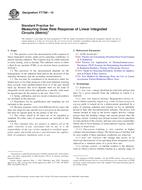We need your consent to use the individual data so that you can see information about your interests, among other things. Click "OK" to give your consent.
ASTM F773M-10
Practice for Measuring Dose Rate Response of Linear Integrated Circuits [Metric]
STANDARD published on 1.5.2010
The information about the standard:
Designation standards: ASTM F773M-10
Note: WITHDRAWN
Publication date standards: 1.5.2010
SKU: NS-56403
The number of pages: 6
Approximate weight : 18 g (0.04 lbs)
Country: American technical standard
Category: Technical standards ASTM
Annotation of standard text ASTM F773M-10 :
Keywords:
circuit response, dose rate, integrated circuit, ionizing radiation, linear circuits, linear integrated circuits, pulsed radiation, transient response, Circuitry, Current measurement--semiconductors, Destructive testing--semiconductors, Dose rate threshold, Dosimetry, Electrical conductors (semiconductors), Electron linear accelerator, Flash X-ray machines (FXR), Integrated circuits, Ionizing radiation, Irradiance/irradiation--semiconductors, Lasers and laser applications
Additional information
| Significance and Use | ||||||||
|
There are many kinds of linear integrated circuits. Any given linear integrated circuit may be used in a variety of ways and under various operating conditions within the limits of performance specified by the manufacturer. The procedures of this practice provide a standardized way to measure the dose-rate response of a linear integrated circuit, under operating conditions similar to those of the intended application, when the circuit is exposed to pulsed ionizing radiation. Knowledge of the responses of linear integrated circuits to radiation pulses is essential for the design, production, and maintenance of electronic systems that are required to operate in the presence of pulsed radiation environments. |
||||||||
| 1. Scope | ||||||||
|
1.1 This practice covers the measurement of the response of linear integrated circuits, under given operating conditions, to pulsed ionizing radiation. The response may be either transient or more lasting, such as latchup. The radiation source is either a flash X-ray machine (FXR) or an electron linear accelerator (LINAC). 1.2 The precision of the measurement depends on the homogeneity of the radiation field and on the precision of the radiation dosimetry and the recording instrumentation. 1.3 The test may be considered to be destructive either for further tests or for other purposes if the total radiation ionizing dose exceeds some predetermined level or if the part should latch up. Because this level depends both on the kind of integrated circuit and on the application, a specific value must be agreed upon by the parties to the test. (See 6.10.) 1.4 Setup, calibration, and test circuit evaluation procedures are included in this practice. 1.5 Procedures for lot qualification and sampling are not included in this practice. 1.6 Because response varies with different device types, the dose rate range for any specific test is not given in this practice but must be agreed upon by the parties to the test. 1.7 The values stated in SI units are to be regarded as standard. No other units of measurement are included in this standard. 1.8 This standard does not purport to address all of the safety concerns, if any, associated with its use. It is the responsibility of the user of this standard to establish appropriate safety and health practices and determine the applicability of regulatory limitations prior to use. |
||||||||
| 2. Referenced Documents | ||||||||
|
We recommend:
Technical standards updating
Do you want to make sure you use only the valid technical standards?
We can offer you a solution which will provide you a monthly overview concerning the updating of standards which you use.
Would you like to know more? Look at this page.




 Cookies
Cookies
